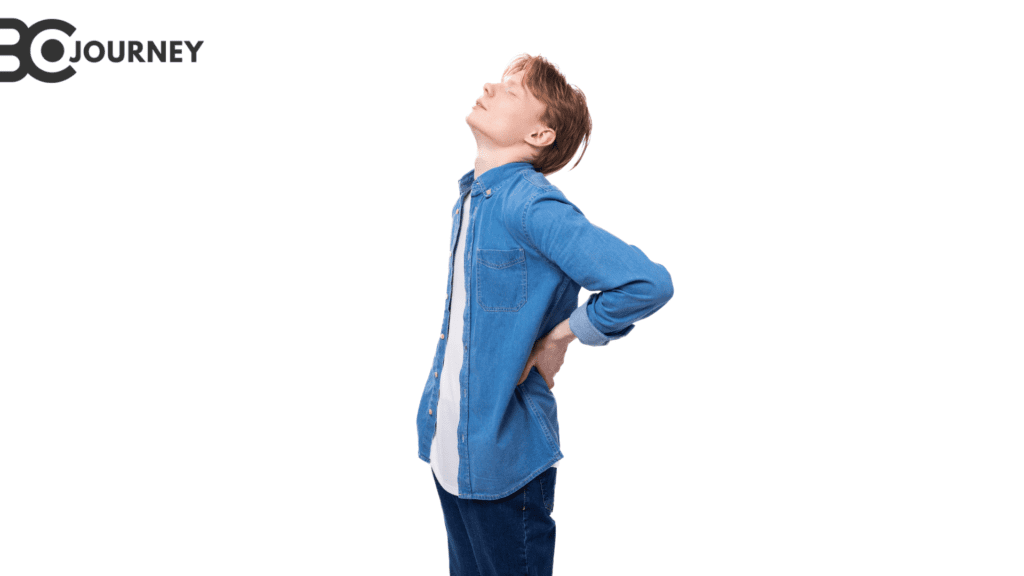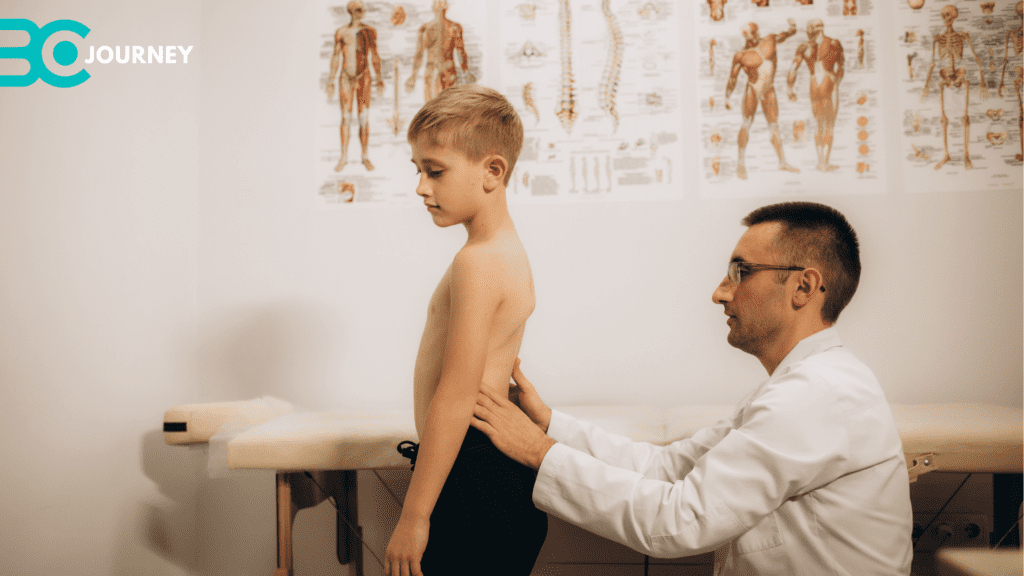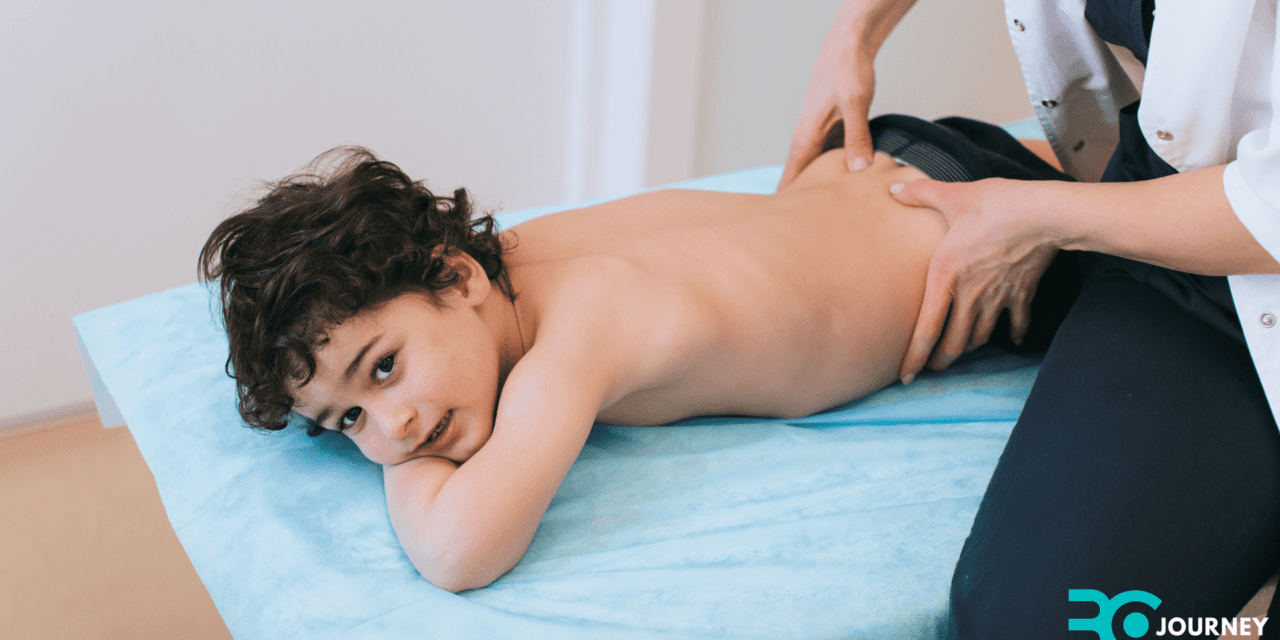Understanding Back Pain in Children and Teenagers
backpain in children and teenagers is very common these days. It can not only affect their quality of life but also make it difficult to stay in class or participate in athletic events.
Although it is generally believed that adults suffer from back pain, in reality, young people are not exempt from this ailment. Parents need to understand why back pain occurs in children and teens, as well as how to best treat it or take preventive measures before any injury becomes irreversible.
Causes of Back Pain in Children and Teenagers
Understanding the causes of back pain in children and adolescents is the starting point for better treatment and prevention. The causes of back pain in children and adolescents can be different from one another. Each cause requires different steps to address.
1. Poor Posture and Its Impact on Back Pain
One of the most common causes of back pain in children and adolescents is downward pressure from poor posture. Today’s youth, who spend long hours on gaming machines, and activities that keep them moving, develop “tech neck” disease. Also, poor posture puts pressure on the muscles and ligaments of the back (especially the upper region), causing discomfort and pain.
2. Heavy Backpacks and Their Role in Back Pain
Another major cause of back pain in children and adolescents is carrying around heavy bags. Children who carry a backpack that often exceeds 10-15% of their body weight put excessive stress on their back muscles and spine.
Improper weight distribution, especially when carrying bags on one shoulder, can lead to muscle imbalances and chronic back pain.
3. Sports Injuries and Back Pain in Active Teens
Participating in sports is generally healthy for the human body. However, this activity is occasionally a source of back pain in children and adolescents. Sprains, strains, muscle tears, or worse, can all occur from repetitive twisting or bending motions while participating in sports such as gymnastics, soccer, and weightlifting.
4. Growth Spurts and Back Pain During Adolescence
Adolescence is a time of growth–the whole body grows toward fitness to meet certain particular needs that can only be addressed when fully grown. During growth spurts, children may experience back pain because of muscle imbalances and the stretching of spines. These changes can temporarily impact posture, leading to discomfort in the back especially lower down.
5. Underlying Medical Conditions and Chronic Back Pain
Sometimes, back pain in children and teenagers can be a sign of some hidden medical condition. Conditions like Scoliosis (an abnormal sideways curvature of the spine), spondylolysis (a stress fracture in one of the vertebrae), or spondylolisthesis, when a vertebra moves forward out of place, can bring on crippling back pain its survivors live with daily. These conditions require thorough examination and often special treatment.
Symptoms of Back Pain in Children and Teenagers

Recognizing the symptoms of back pain in children and teenagers is critical for early intervention and effective treatment. Symptoms can depend on the type and severity of pain you are dealing with, but some signs should alert you to get help immediately.
1. Localized Pain and Its Significance
localized pain is One of the most common symptoms of back pain in children and teenagers. Its location can be anywhere in the upper or lower areas of the back and is generally sharp or dull. Localized pain often indicates muscle strain, bad posture and other small injuries.
2. Radiating Pain: When Back Pain Spreads
In some cases, back pain in children and teenagers may radiate to other parts of the body. For example, a herniated disc in the lower back can cause sciatica, where pain radiates down the leg. Similarly, pain from the upper back can extend into the shoulders or arms, suggesting nerve involvement.
3. Stiffness and Reduced Mobility in the Spine
Back pain in children and teenagers can also manifest as stiffness and reduced range of motion. A child may find it impossible to bend, twist, or move his back freely; this can affect his daily activities such as taking part in sports or even sitting in class. Stiffness is normally because of muscle tension or inflammation.
- Muscle Spasms as a Response to Injury
Muscle cramps are another symptom of back pain in children and Teenagers. It should be noted that back spasms are the body’s way of protecting itself from injury by anticipating its response. When your muscles involuntarily contract on their own, they can become painful.
This can cause muscle spasms that restrict movement and prompt treatment is essential to relieve the pain.
5. Changes in Posture Due to Back Pain
Back pain can result in a child’s posture that is obviously out of alignment. For example, a teenager with back pain may start to sag forward or walk with one side of the body bowing under some pretty unusual loads. These changes in position are usually compensatory measures for the relief of pain but may result in even further complications if not taken care of properly.
Diagnosis of Back Pain in Children and Teenagers

When managing children and teenagers with back pain it is essential to have a systematic approach due to the multiple factors that might play an etiological role.
Early, accurate assessment will help to identify the appropriate treatment by minimizing chronic pain and complications. Below is how the diagnosis usually pans out
Medical History
The first step in diagnosing back pain in children and teenagers is to get a good description of their medical history. This includes asking the child and parents when the pain started, how long it has been present, and what part of their anatomy is uncomfortable. For example, the healthcare professional will inquire whether the pain was sharp or dull, intermittent or continuous. It also is important to know if the pain becomes worse with certain activities, such as sports, or whether it gets better after resting for a length of time.
The medical history will also delve into any previous injuries or conditions that could be playing a role in the current back pain. A family history of back problems, such as scoliosis or arthritis, may furthermore offer some helpful information. To try and identify contributing factors that might be increasing pain, the child’s daily habits are examined. This includes their stance during schoolwork, use of backpacks, and involvement in sports activities.
Physical Examination
After taking the medical history, a complete physical examination is conducted. This examination lets the healthcare provider inspect the physical structure of the spine, muscles, and overall posture. During the physical examination, the provider makes note of the child’s gait and posture, watching for any abnormalities or signs that the child is not comfortable.
The range of motion tests is particularly important, where the child will be asked to bend forward, backward, and sideways to determine if there is any restriction in movement or if specific motions trigger pain. Additionally, the provider may palpate the spine and surrounding muscles to identify any areas of tenderness, muscle spasms, or structural anomalies like misalignment or swelling.
In severe cases, especially when there is concern over nerve issues, the physical examination may also include neurologic testing. Examples include muscle strength, reflexes, and sensation. For example, children with a herniated disc may present signs of nerve compression such as reduced reflexes or muscle weakness in the legs.
Imaging Studies
When back pain persists or if the physical examination raises concerns, imaging studies are often the next step in the diagnostic process. These studies give detailed pictures of the spine and surrounding structures and can identify any structural abnormalities, injuries, or other conditions that might be contributing to the pain.
X-rays
X-rays are typically the first imaging test ordered when evaluating back pain in children and teenagers. This quick and non-invasive procedure provides valuable information about the alignment of the spine and can reveal structural issues such as scoliosis, fractures, or other abnormalities in the bones.
X-rays are particularly useful for assessing the vertebrae and detecting any signs of bone degeneration or misalignment that might be causing pain.
Magnetic Resonance Imaging (MRI)
Magnetic resonance imaging (MRI) is an advanced imaging technique that produces detailed images of the soft tissues surrounding the spine, including muscles, ligaments, discs, and nerves. MRI is particularly useful when the healthcare provider suspects issues like herniated discs, abnormalities of the spinal cord, or soft tissue injuries that cannot be seen through X-rays.
MRI is often used if the child’s back pain is severe, persistent, or if there are neurological symptoms like numbness or weakness. The detailed images from an MRI can be crucial in diagnosing conditions such as disc herniation’s, tumors and infections. And it’s a crucial tool for planning surgical interventions if necessary.
Computed Tomography (CT)
Computed tomography (CT) scans offer a different way of getting at what’s wrong with a child’s back pain. They combine photographs taken from different angles to create cross-sectional views of the spine. By superimposing these images, CT scan technology gives a three-dimensional picture of what’s really happening inside your child.
Because it offers more detailed images than traditional x-rays, this is especially useful for finding hard-to-spot bone fractures, à condition called spinal stenosis or bone deformities where the bone tissue is not destroyed but still twisted.
CT scans are often recommended when more detailed information is needed to diagnose the cause of back pain or when MRI is not available or suitable for the patient.
Bone Scan
While usually used to find problems with the bones like fractures, infections, or tumors as a source of back pain; specific bone scans can provide a lot helpful information. During a bone scan, a small amount of radioactive isotope is introduced into the bloodstream, and a special camera is used to detect the radiation emitted by the material as it accumulates in the bones.
Areas of high bone activity, such as sites of inflammation, infection, or abnormal growth, will appear brighter on the scan. In this way bone scans can provide valuable information about the cause of a patient’s pain. If other imaging tests like x-rays or MRI do not give sufficient information to establish good diagnosis, then bone scanning is particularly useful.
Additional Tests
In some cases, other tests are necessary to determine the cause of back pain in children and teenagers. These tests help diagnose the specific problem that underlies their condition and form the basis of a treatment plan.
Blood Tests
Blood tests may be ordered on occasion as a rule-out or confirmation tool for a specific disease suspected, such as an infection or inflammation. Blood tests are sensitive enough to catch markers of inflammation in the blood, such as elevated erythrocyte sedimentation rate (ESR) or CRP (C-reactive protein).
Blood tests can also identify other underlying health issues, such as vitamin D deficiency or anemia, which might contribute to musculoskeletal pain.
Diagnostic Spinal Injections
Diagnostic spine injections can be used to both diagnose and treat back pain. These injections typically contain a local anesthetic and, on occasion, a corticosteroid. Injections are given at such specific points as a nerve root or facet joint in the spine.
healthcare providers can determine whether that area is the source of the pain. If the pain is relieved following the injection, it confirms that the targeted area is indeed the source of the problem.
These injections can also help to reduce inflammation and provide temporary pain relief, making them both a diagnostic and therapeutic tool in managing back pain.
Prevention tips for children and teens about back pain
Encourage Proper Posture During Daily Activities
For both children and teenagers, good posture can help to prevent back pain. With digital device use on the rise, many young people spend hours sitting in positions that are hard on their backs.
Encourage them to sit with a straight back, shoulders relaxed, and feet flat on the floor. When standing, they should keep their shoulders back and avoid slouching. Simple posture checks during the day can yield great results.
Adjusting desks, chairs, and screens to the correct height can help maintain a neutral spine and reduce strain. Educating children on good posture early on helps instill habits that support lifelong spinal health.
Limit the Weight and Correct Use of Backpacks
Carrying heavy backpacks is a major cause of back pain in children and teenagers. To avoid strain, make sure the child’s backpack does not exceed 10-15% of his body weight.
Load the heavier items closest to the back and carry the backpack on both shoulders. Which spreads the weight evenly across the shoulders and back, relieving muscle strain and imbalance. Check the contents of the backpack frequently to eliminate superfluous items.
Choosing a backpack with padded straps and proper support can alleviate pressure on the spine.
Promote Regular Physical Activity and Core Strengthening
Regular physical activity is essential to maintaining a healthy spine and preventing back pain. Encouraging children and adolescents to take part in sports, dancing, and other activities keeps the muscles around their spine strong. Core-strengthening exercises such as planks or bridges are an ideal way of improving stability and reducing the chance of injury.
Also, encouraging regular breaks during long periods of sitting helps prevent stiffness and encourages flexibility. An active life that includes core exercises provides a solid foundation for holding up overall spinal health.
Educate on Safe Lifting Techniques
Educating children and adolescents about safe lifting is vital to preventing back injuries. They should be taught to bend at the knees and hips rather than the waist when lifting, using their leg muscles for support.
To remain balanced while lowering or repositioning the object under load, keep it close to your body. If an object is too heavy or awkward to carry on your own, ask for help. Reinforcing these safe methods can help avoid strains and back injuries.
Ensure Ergonomic Study and Sleep Environments
Making the study and sleep environment ergonomic is essential to prevent back pain. Study areas must have the right height for desks, chairs, and a computer screen that is at eye level to avoid straining your neck and back.
For sleep, the mattress should support the natural curve of the spine and the pillow should keep your head in position aligned with your body. By adjusting these environments properly back pain is usually reduced substantially in each area while also promoting better spinal health.
When Children and Teenagers Should See the Doctor for Back Pain
Sometimes backpain in children and teenagers is managed with home treatment, there are certain situations where medical attention is necessary. Knowing when to seek professional help can prevent more serious complications and ensure appropriate care.
1. Persistent Back Pain That Doesn’t Improve
If back pain in children and teenagers has persisted for more than a few weeks without any improvement, it would be best to see a doctor. Persistent pain that didn’t respond to rest or home treatment could be due to an underlying medical condition requiring evaluation
2. Severe Pain Accompanied by Neurological Symptoms
Back pain, along with other symptoms like numbness, weakness, falling, and trouble walking, couldn’t be ignored and would require immediate evaluation by a health care provider. These symptoms might suggest nerve involvement or a more serious spinal condition.
3. Back Pain Following an Injury
If you experience back pain after a fall, accident or sports-related injury consult with your doctor. That goes for even mild pain Ignoring that can lead to fractures, spinal injuries, and more serious things if overlooked.
4. Systemic Symptoms Accompanying Back Pain
the presence of systemic symptoms, such as fever, unexplained weight loss, and fatigue, could suggest that the back pain is a symptom of a more serious underlying condition, such as an infection, tumor, or other surgical emergency. When children’s ability to do their daily activities sports, school, sleep on a regular basis is affected, it’s the time to call a doctor.
5. Interference with Daily Activities and Sleep
The presence of back pain should also be supported by activity limitations, such as the inability of a child or teen to perform usual activities, participate in sports, or go to school. Additionally, pain associated with this condition may interfere with sleep.
Home Treatment for Back Pain in Children and Teenagers
In most cases, pediatric and adolescent back pain can be successfully managed at home, with proper care and attention. Home treatment interventions used in these situations are targeted at supporting pain relief, healing promotion, and prevention of future occurrences. Home treatment options for addressing back pain associated with these issues include:
1. Rest and Activity Modification
Encourage bed rest and lifestyle adjustments that can relieve back pain. Bedrest is not recommended, but modifying activities such as sports or heavy lifting can facilitate the healing of your back
2. Applying Heat and Cold Therapy
The pain in the back of children and teenagers can be greatly reduced even with hot bags or ice packs, as well.
Icing the painful area in the first 48 hours helps soothe inflammation while heat therapy can alleviate muscle tension and increase blood flow to that particular part of your body
3. Over-the-Counter Pain Relievers
Pain (and sometimes inflammation) can be controlled with over-the-counter pain relievers such as ibuprofen or acetaminophen in children and teenagers with back pain. These medicines help children get back to normal activities and should be taken as prescribed.
4. Gentle Stretching and Strengthening Exercises
Add gentle stretching and strengthening exercises to your child’s daily routine can help reduce back pain, as well as prevent it from recurring.
All exercises that extend the back, and stretch the hamstrings and hip flexors may be beneficial for developing flexibility as well as reducing tension in muscles.
5. Maintaining Proper Posture
Establishing good posture plays a vital role in treating as well as preventing back pain in children and teenagers. If one is sitting, standing, or using electronic devices then ensuring a neutral spine with back straight and shoulders pushed backward can help reduce the strain on the back.
Conclusion on Addressing Back Pain in Children and Teenagers
Back pain in children and adolescents is a serious condition that requires some special attention and care. Knowing the risk factors, symptoms, and when to seek immediate medical attention can help parents and caregivers protect their children’s health.
Timely diagnosis, appropriate treatment, and preventive care ensure that back pain does not become a lifelong problem for youngsters.
Frequently Asked Questions About Back Pain in Children and Teenagers
Is it normal to have back pain at 17 years old?
Yes, it’s not unusual for 17-year-olds to experience back pain, especially if they play sports, carry heavy backpacks, and their posture is poor. However, while an occasional ache may be accepted as part of growing up, prolonged and severe back pains should serve as reminders for the whole family to take action.
If it doesn’t work out soon or gets worse rather than better over time, anyone who is suffering like this needs to promptly refer to a healthcare professional.
Is it normal to have back pain at 18 years old?
Back pain at 18 years of age is not uncommon, especially given the physical and lifestyle changes that occur during late adolescence. Factors such as growth spurts, increased physical activity and posture-related issues can all contribute to back pain in those years.
However, check the pain, especially if it is a regular presentation, serious, or already impacting daily activities. Consult a doctor to ensure the pain is not a symptom of something more serious.
When should I be concerned about my child’s back pain?
If your child’s back pain is persistent, that is, lasting longer than a few weeks and not getting any better; if it is severe and comes with other symptoms such as numbness, weakness, and so on.
In addition, if the pain follows an injury or goes along with systemic symptoms like fever, unexplained weight loss, or fatigue, definitely seek medical attention. Early diagnosis and treatment can prevent further problems and help manage the pain effectively.
What are the common causes of back pain in adolescents?
The most common causes of back pain in teenage years include muscle strain from physical activities, poor posture, heavy backpacks, and growing pains.
In addition, there can also be underlying medical conditions such as scoliosis, herniated discs, or spondylolisthesis resulting in back discomfort, specific diagnosis is necessary for effective treatment and prevention of future episodes.
Can heavy backpacks cause back pain in children and teenagers?
Yes, heavy backpack is a common cause of back pain in children and teenagers. When a child is carrying a backpack that is too heavy or used improperly, it can cause their back muscle and spine to experience undesired stress. To avoid that, it is essential to make sure that the weight of the backpack does not exceed 10-15% of the total body weight. Additionally, they should utilize both shoulder straps to correctly divide the weight on their shoulder.

